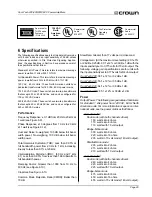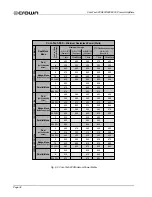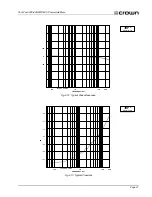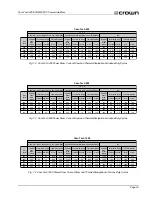
Page 42
Com-Tech 200/400/800/1600 Power Amplifiers
7 AC Power Draw and
Thermal Dissipation
This section provides detailed information about the
amount of power and current drawn from the AC
mains by
Com-Tech amplifiers and the amount of heat
produced under various conditions. The calculations
presented here are intended to provide a realistic and
reliable depiction of the amplifiers. The following as-
sumptions or approximations were made:
• The amplifier’s available channels are loaded, and full
power is being delivered.
• Amplifier efficiency at standard 1 kHz power is esti-
mated to be 65%.
• In 8/4 ohm mode, typical quiescent power draw is 20
watts for the
Com-Tech 200, 30 watts for the Com-Tech
400, 55 watts for the Com-Tech 800 and 70 watts for
the
Com-Tech 1600.
• In 70 volt mode, typical quiescent power draw is
30 watts for the
Com-Tech 200, 35 watts for the
Com-Tech 400, and 90 watts for the Com-Tech 800
and
1600.
• When running at full speed, typical power draw for the
internal fan is 11 watts for the
Com-Tech 200, 400 and
800, and 17 watts for the Com-Tech 1600 (the fan is
an option for the
Com-Tech 200).
• Quiescent thermal dissipation is related .
• The estimated duty cycles take into account the typi-
cal crest factor for each type of source material.
• Duty cycle of pink noise is 50%.
• Duty cycle of highly compressed rock ‘n’ roll midrange
is 40%.
• Duty cycle of rock ‘n’ roll is 30%.
• Duty cycle of background music is 20%.
• Duty cycle of continuous speech is 10%.
• Duty cycle of infrequent paging is 1%.
Here are the equations used to calculate the data pre-
sented in Figures 7.1 through 7.4:
AC Mains Power
Draw (watts)
=
Total output power with all
channels driven (watts)
x Duty
Cycle
Amplifier Efficiency (.65)
+ Quiescent Power
Draw (watts)
The value used for quiescent power draw includes
both the amplifier’s quiescent power draw for the se-
lected output mode and the power drawn by the fan if
one is installed (these values are listed in the previous
column). The following equation converts power draw
in watts to current draw in amperes:
Current Draw
(amperes)
=
AC Mains Power
Draw (watts)
x
AC Mains
Voltage
Power
Factor (.83)
The power factor of 0.83 is needed to compensate for
the difference in phase between the AC mains voltage
and current. The following equation is used to calcu-
late thermal dissipation:
Total output power with all
channels driven (watts)
Thermal
Dissipation
(btu/hr)
=
+
Quiescent Power
Draw (watts)
x
.35
Duty
Cycle
x
Amplifier Efficiency (.65)
(
)
x 3.415
The constant 0.35 is inefficiency (1.00 – 0.65) and the
factor 3.415 converts watts to btu/hr. Thermal dissipa-
tion in btu is divided by the constant 3.968 to get kcal.
If you plan to measure output power under real-world
conditions, the following equation may also be helpful:
Total measured output power
from all channels (watts)
Thermal
Dissipation
(btu/hr)
=
+
Quiescent Power
Draw (watts)
.35
x
Amplifier Efficiency (.65)
(
)
x 3.415
8 Ohm Dual / 16 Ohm Bridge-Mono / 4 Ohm Parallel-Mono
L O A D
50%
40%
30%
20%
10%
200
165
135
100
65
305
265
225
185
145
265
215
170
125
80
95
85
70
55
40
210
175
145
110
75
340
300
260
220
180
2.4
2.0
1.6
1.2
0.8
3.1
2.6
2.0
1.5
0.9
2.5
2.1
1.7
1.3
0.9
Duty
Cycle
AC Mains
Power
Draw
(Watts)
btu/hr
Current Draw (Amps)
1.1
0.9
0.7
0.5
0.3
1.4
1.2
0.9
0.7
0.4
1.1
1.0
0.8
0.6
0.4
4 Ohm Dual / 8 Ohm Bridge-Mono / 2 Ohm Parallel-Mono
70 V
Com-Tech 200
80
70
60
50
40
kcal/hr
380
325
270
215
160
85
75
65
55
45
100-120 V 220-240 V
Thermal Dissipation
btu/hr
Current Draw (Amps)
kcal/hr
100-120 V 220-240 V
Thermal Dissipation
btu/hr
Current Draw (Amps)
kcal/hr
100-120 V 220-240 V
Thermal Dissipation
AC Mains
Power
Draw
(Watts)
AC Mains
Power
Draw
(Watts)
Fig. 7.1 Com-Tech 200 Power Draw, Current Draw and Thermal Dissipation at Various Duty Cycles








































